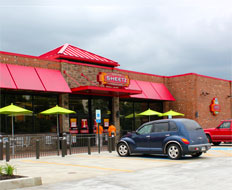C-stores are continuing to tread heavier on quick-serve restaurants’ turf, with one major convenience player now spotlighting its food offerings in its marketing efforts.
The latest advertising campaign from Sheetz, a regional, 400-unit convenience-store chain headquartered in Altoona, Pennsylvania, uses this tag line: “Just because we don’t look like a restaurant doesn’t mean we’re not one.” The new TV spots show actors seating themselves at high-top tables in a dining area.
“Internally, these ads have had a positive effect,” says Louie Sheetz, executive vice president of sales and marketing for the company. “We are a great gas station, but we are also trying to make our image as a place with restaurant-quality food and beverages.”
Sheetz says the paradigm of the “old gas station” is not gone, and that convenience stores are not where people think of to go buy food. At Sheetz, executives are hoping the public sees things the way the company sees them: that the convenience store is a place for gas but also freshly made food. Sheetz has been doing made-to-order sandwiches for 20 years.
The ads, which target males ages 16–24, have a quirky vibe and are running in the North Carolina market, where the company has stores with drive-thru windows. The campaign reflects a new dedication to foodservice by the company; all of its new stores moving forward will have special dining areas.
Convenience stores have long offered snacks and other basic foods to offer meals when no other alternatives are available to consumers. But today’s C-stores are out to attract more meal-time consumer dollars, threatening to steal customers from quick serves.
“The lines were already blurred,” Sheetz says about the distinction between a quick-serve restaurant and convenience-store foodservice. “We are all competing for that share of the stomach.”
According to Technomic, limited-service restaurants did $200 billion in sales in 2011, while convenience stores did $10.5 billion. A Technomic survey shows that 7 percent of consumers headed to a C-store for a meal; 67 percent, meanwhile, headed to a quick serve. The head-to-head numbers may seem one-sided, but competition is fierce, and when it's for billions of dollars, even fractions of percentages can mean a lot to individual operators.
“Most C-stores are meeting existing demand,” says Brandon O’Dell, owner of O’Dell Restaurant Consulting in Kansas City. “Everyone who walks through the door has to eat lunch, so C-store owners are going to try to get them to eat in their stores.”
Technology has helped the crossover. Cooking equipment is smaller, faster, and easier to use, O’Dell says, which makes putting out quality food consistently and in a timely fashion easier than ever before.
“It was easy for C-stores on highways to cobrand with franchises, but the stores in cities had to look for cost-effective ways to get those food dollars,” O’Dell says. “Smaller stores can’t afford to become part of a food franchise, but they still see the opportunity. They follow the same model, but scale it down to meet their needs.”
Sheetz has embraced technology with touch screens for ordering, making every sandwich a custom-built event.
“Our roots are in quality,” Sheetz says, “and giving people choices has helped pave our way into the quick-serve market.”
Timothy Powell, director of research and consulting at Technomic, says C-stores will continue paving that way into the quick-serve market as they evolve their foodservice offerings. But he doesn’t think the impact on quick serves will be too severe.
“Realistically, everyone is a competitor—fine dining is losing business to casual dining, casual dining is losing business to quick service, and quick service is losing business to C-stores,” he says. “Everyone is trying to get that foodservice dollar. The big factor is how they will differentiate themselves.”
Powell says that even though C-store operators should focus more on competing with their convenience peers than with quick-serve restaurants, companies like Sheetz and Wawa—a Wawa, Pennsylvania–based C-store chain—are changing consumers’ perception on convenience stores, which could reap benefits for the whole industry.
“Sheetz and Wawa are ahead of their competitors,” he says. “People don’t think about going to the convenience store, they think about going to Sheetz or going to Wawa. These stores have moved way beyond being just a gas station. They are fun, bright, clean, and inviting.”
“This is a trend that is not going away,” O’Dell says, “and quick-serve restaurants should be prepared for it.”





